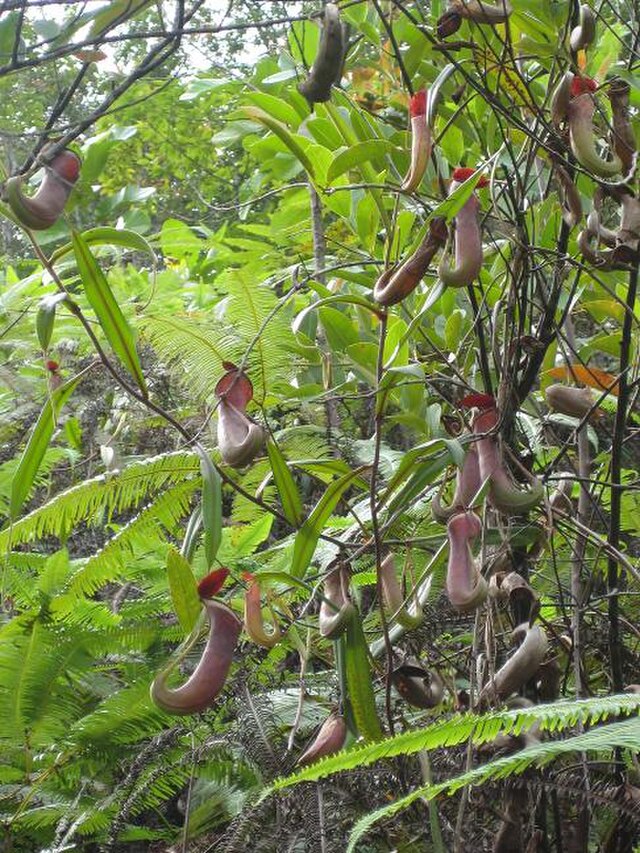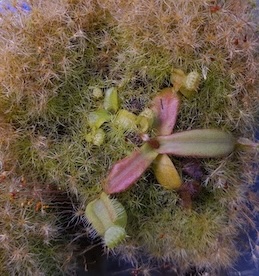

Nepenthes albomarginata
General
Nepenthes albomarginata is a unique and visually striking tropical pitcher plant native to parts of Southeast Asia. Its name, meaning “white-margined,” refers to the characteristic white band of specialized hairs on the upper pitcher rim—a fascinating adaptation for catching prey, especially termites. Well-loved among carnivorous plant enthusiasts, it stands out for both its gentle beauty and its specialized feeding habits.
Physical Characteristics
Pitchers are slender and cylindrical, typically green or red with the defining white fringe just below the mouth. Mature pitchers can reach 10–15 cm (4–6 inches) in height. The main stem produces delicate, lance-shaped leaves that are glossy green. The white band of trichomes (hair-like structures) around the pitcher’s peristome is both diagnostic and functional.
Lifestyle
This species relies on its pitfall trap strategy: attracting prey, especially termites, to the white trichome band before they slip and fall into digestive fluids within the pitcher. Nepenthes albomarginata absorbs nutrients from its trapped prey to supplement the usually poor soils it inhabits. Unlike most of its relatives, it is especially adapted to live in both shaded and more open environments.
Habitat and Protection
The natural range includes lowland peat and kerangas (heath) forests in Borneo, Peninsular Malaysia, and Sumatra, with a strong preference for acid, sandy soils. It has a patchy distribution, often in areas with partial sunlight and high humidity. While not critically endangered, habitat loss is a growing threat, making conscientious cultivation important.
Cultivation
Cultivating this plant successfully requires replicating its native conditions: high humidity, bright but filtered light, and consistently moist, acidic substrate. It is best suited to greenhouses, terrariums, or dedicated grow spaces, especially in non-tropical climates.
Special Features
- The only Nepenthes species known to specialize in termite predation, thanks to the distinctive white hairy band.
- Can thrive in a wider range of light conditions than many other Nepenthes, making it more adaptable for hobbyists.
- Its delicate pitchers and specialized appetite make it a conversation piece in any collection.
Care
Light
Provide bright, filtered light year-round. Dappled sunlight is ideal; avoid harsh midday sun, which can scorch the leaves.
Temperature
Maintain warm, stable temperatures: 22–30°C (72–86°F) during the day, not dropping below 15°C (59°F) at night.
Water
Use only rainwater, distilled, or deionized water. The soil should be kept moist at all times but not waterlogged. Never allow the growing medium to dry out.
Soil
A loose, acidic mix without fertilizer or minerals is crucial. Common recipes include sphagnum moss, perlite, and a small amount of sandy material for drainage.
Nutrition
Pitchers will naturally catch insects, but supplemental feeding (termites or small insects) can be offered. Avoid chemical fertilizers, as roots are sensitive.
Humidity
High humidity is key: 60–90% relative humidity is best. If grown indoors, frequent misting or a humidifier may be necessary.
Dormancy
This species does not have a true dormancy period—keep conditions stable throughout the year to support constant growth.
Common Problems
Pitchers fail to form
Cause: Low humidity or insufficient light.
Solution: Increase humidity using a terrarium or humidifier, and ensure the plant receives bright, filtered light.
Leaves turn yellow or brown
Cause: Water quality issues or overwatering.
Solution: Switch to pure rain, distilled, or reverse osmosis water; check that the substrate is moist but not soggy.
No new growth or slow growth
Cause: Too cold or insufficient light.
Solution: Ensure temperatures stay above 15°C (59°F) and increase indirect light.
Pitchers dry up prematurely
Cause: Air is too dry or there is a sudden change in environment.
Solution: Stabilize humidity, avoid cold drafts, and acclimatize the plant gradually to new settings.
